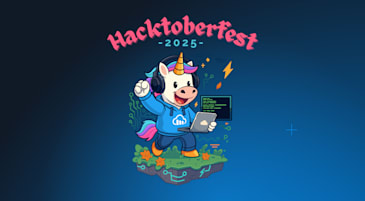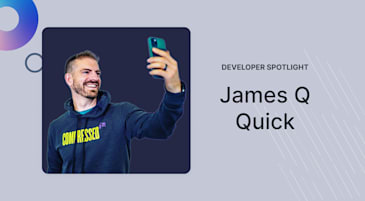Jerome Hardaway knows first-hand that learning to code can change a veteran’s life. As the founder of Vets Who Code, he’s built a nonprofit that equips veterans with the technical skills, mentorship, and confidence to transition into thriving tech careers. We recently sat down with Jerome and discussed what inspired him to start the program, how military experience translates into coding success, and where he sees opportunities for Cloudinary’s developer community to get involved.
What first motivated you to start Vets Who Code?
I was first motivated to start Vets Who Code after an incident about 11-12 years ago when I helped a family raise money to bury a veteran using technology. That moment made me realize how powerful tech could be in changing lives. At first, I thought I would leave social enterprise work and focus on my own career, but people told me I couldn’t just walk away.
When I examined my own life, I saw that tech had given me focus, purpose, community, and options. Through tech, I was able to find community across states, online, and even globally. More importantly, I could use tech to help others, which is central to who I am as both a veteran and a human being.
Once I gained technical skills, my life completely changed. I could afford better food, health insurance, and had a disposable income that helped me build community and support my family. Knowing the impact this had on me, I believed it could have the same impact on other veterans transitioning back to civilian life. That belief is what ultimately drove me to create Vets Who Code.
You studied criminal justice, not computer science. What was it like learning code from scratch, and what were the biggest hurdles?
Learning code from scratch with a background in criminal justice was both humbling and challenging. I didn’t come from a computer science program, so I had to build my technical foundation piece by piece. My first hurdle was simply learning how to think like a programmer — breaking big problems into smaller ones, understanding logic flows, and getting comfortable with the idea that failure and debugging are part of the process.
Another challenge was dealing with documentation and technical jargon. At first, it felt like reading a different language. But as a veteran, I was already used to reading long, dry SOPs and applying them in practice, so once I reframed it, technical documentation became much easier to navigate.
The biggest hurdle, though, was confidence. Coming from outside the traditional tech track, it was easy to feel like I didn’t belong. But I stayed disciplined, leaned on community, and treated every coding challenge like training — showing up consistently until I broke through. Over time, those small wins added up, and eventually coding became second nature.
In your view, what makes veterans particularly well-suited to succeed in coding and tech careers?
Veterans are particularly well-suited for coding and tech careers because of traits we develop in service that translate directly to software engineering. We bring tenacity. When something is hard, we keep at it until the job gets done. We are already trained to read and act on dry, detailed SOPs, so modern technical documentation feels manageable by comparison.
Adaptability is another strength. In the military, we often have to solve problems with limited tools or under pressure, and that mindset carries into tech, whether debugging with minimal resources or learning new frameworks quickly. Veterans also excel at pattern recognition, focus, and discipline.
For those who come from combat arms roles, channeling that intensity into coding can be difficult at first. But once the focus clicks, it often becomes an obsession. That combination of discipline and drive means the ceiling is high. When veterans commit to tech, they have the potential to go very far.
What role do you see Cloudinary and platforms like it playing in building inclusive developer communities?
Cloudinary and platforms like it play a critical role in building inclusive developer communities by lowering the barrier to entry and making it easier for people to learn through practical, hands-on experiences. Tools that are accessible, well-documented, and visually engaging help beginners gain confidence faster. They also provide instructors and mentors with resources to teach effectively and create workshops that reach people who might not have traditional tech backgrounds.
By giving veterans and other nontraditional developers exciting tools to work with, platforms like Cloudinary can draw them into the ecosystem and keep them engaged. Visual storytelling, in particular, is powerful because so much of the web is image-driven. When people see their work come alive through images and media, they stay motivated to build more.
Cloudinary also has the opportunity to support the community through mentorship, especially across tracks like Next.js, Python, and data engineering. Inclusive developer communities grow stronger when experienced engineers share their knowledge, and when products empower learners to create real-world projects that showcase their skills.
What opportunities exist for Cloudinary’s developer community to engage with and support Vets Who Code?
Opportunities for Cloudinary’s developer community to engage with and support Vets Who Code exist on multiple levels. One major area is mentorship. Our veterans are learning technologies like Next.js, Python, and data engineering, and they benefit greatly from guidance on how to build, maintain, and scale production codebases. Having Cloudinary engineers step in as mentors would give them direct insight into industry standards and practices.
Another opportunity lies in showcasing the power of visual storytelling. Much of what we teach is tied to real-world product development, and images and media are central to how stories get told online. Cloudinary’s expertise in managing and delivering media can help our veterans understand how to build applications that are not only functional but also compelling.
Workshops, technical deep dives, and collaborative projects are also areas where Cloudinary’s community can make a strong impact. By sharing knowledge of best practices, performance optimization, and media workflows, Cloudinary can help prepare our veterans for roles where those skills are in high demand.
Finally, timing matters. We are especially focused on strengthening our community and curriculum for 2026. Having Cloudinary involved as a partner in mentorship, education, and technical support would ensure our veterans are equipped with the skills and confidence they need to thrive in the tech industry.
Which coding languages, frameworks, or tools do you focus on and how do you decide what to include or retire?
In 2026, we will teach three core verticals to all accepted troops: Software Engineering, AI Engineering, and Data Engineering.
- Software Engineering will focus on TypeScript, Tailwind, Next.js, GitHub, GitHub Actions, and terminal proficiency. We use Vercel for deployment and emphasize real-world coding practices that prepare veterans to build and maintain production applications.
- AI Engineering will be centered on Python, SQL, Azure AI, and Google Gemini. These skills position veterans to create and deploy AI solutions that meet current and emerging industry needs.
- Data Engineering will cover Python, SQL, and the Azure ecosystem. Troops will learn to build data pipelines, manage databases, and provide business-critical insights through data.
We chose these three verticals because they reflect market demand and salary trends, ensuring veterans develop skills that are both relevant and lucrative. By focusing on these tracks, we prepare our community for long-term success in the civilian tech sector.
For veterans who are hesitating to dip their toes into tech, what would you say to encourage them?
I would start by asking what type of veteran they want to be in the civilian sector. Tech is not just about money or titles. It is about being a steward to the community you are joining. Veterans who succeed in tech are the ones willing to learn continuously, collaborate, and leave behind any military toxicity that could harm the community.
If you are willing to treat learning as a lifelong mission, stay disciplined, and be open to growth, then tech can completely change your life. It can give you stability, opportunity, and a new way to serve others. The key is entering with the right mindset: not just to take, but to build and contribute.
Lastly, as technology continues evolving rapidly, how does Vets Who Code stay relevant and future-proof for veterans entering the field?
Vets Who Code stays relevant and future-proof because I do not just lead the organization, I am actively in the trenches writing code, running tests, and shipping projects. Many coding schools are led by people who no longer work in production environments. That creates a gap between what they teach and what the industry actually needs.
I work as a senior AI engineer, senior software engineer, and senior data engineer. I am involved in large launches and high-value projects that give me direct insight into current and emerging trends. That hands-on experience shapes our curriculum and ensures our veterans are learning skills employers want today and five years from now.
This approach is to our advantage. Veterans are not just trained by someone speaking in theory. They learn from someone who is solving real problems daily and sharing how to approach them. By aligning our teaching with market demand and staying embedded in the industry, we keep our program sharp, competitive, and built for the future.



